- Recent changes
- Random page
- View source
- What links here
- Related changes
- Special pages
- Printable version
- Permanent link
- Page information
- Create account

How historically accurate is the Gladiator
This article contains spoilers.
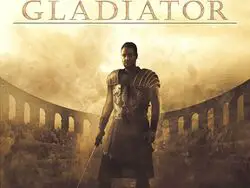
Gladiator was a film released in 2000 starring Russell Crowe that focused on General Maximus Decimus Meridius, who was enslaved after escaping his execution for not supporting the new Roman emperor Commodus (starring Joaquin Phoenix). Maximus rises as a well-skilled gladiator, eventually making it to Rome, where he participates in the gladiator games sponsored by Commodus. After Commodus learns of Maximus, both characters want to kill the other. Maximus attempts to conspire with those in the Senate who dislike Commodus, while Commodus attempts to have Maximus killed in the gladiator battles.
Battles in Germania
The movie begins with the ailing Marcus Aurelius, Rome's emperor, watching Maximus leading a battle against a German tribe. The battle is portrayed as crucial in bringing peace to the Roman Empire's northern frontier. The German tribe was shown wearing Neolithic period clothing, which is inaccurate, and the clothing would have been more complex in fashion. During the reign of Aurelius, there were prolonged wars in Germania.
Although they were close to annexing Moravia and West Slovakia during his reign, wars there were largely inconclusive. The movie depicts the emperor being killed by his son Commodus, although Commodus was already co-emperor. There is no evidence that Commodus had any difficult relationship with his father, although later authors did disparage Commodus. Furthermore, although Maximus is mostly a fictional character, it is not likely Marcus Aurelius would appoint a general as protector of the empire, as suggested in the movie where shortly before his death, the fictional Marcus Aurelius asked Maximus to lead the empire.
In fact, in the film, a conflict in Marcus Aurelius' mind was whether to return power to the Senate rather than have it mostly be with the emperor. This is unlikely as Marcus Aurelius, although often considered a wise emperor and even called the "philosopher-king," as suggested in the film, still believed in holding power closely and willingly passed power to his son, something a Roman Emperor had not done for about a century. [1]
Marcus Aurelius appointed his son as successor long before he died in 166 (he died in 180 CE), making it clear that Commodus was his choice all along. He also died in Vienna (ancient Vindobona), but the film showed him dying in Germania during the campaign. Some rumors and stories did circulate that Commodus did kill his father, but this could have been later stories created to malign the emperor Commodus since he was not well-liked by the Senate, as suggested in the film. The appointment of Commodus was controversial, as shown in the film. From historical documents, mainly in the writings of Cassius Dio, there is an indication that Marcus Aurelius was disappointed in his son, suggesting he had some trepidation about him. Cassius Dio indicates that Rome suffered as Commodus came to power, but this could be part of later propaganda after Commodus's reign. It is hard to tell what is exactly accurate as Commodus may have been more disliked by the upper classes. At the same time, some indication suggests he was popular with the army or even lower classes as a sort of peoples' emperor. [2]
Were the Gladiator Contests shown in Gladiator Accurate?
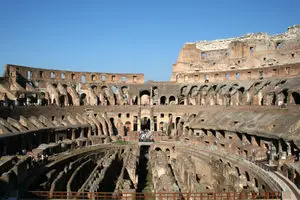
In the film, after Maximus was taken as a slave, but not before he discovered that Commodus killed his wife and son, he was shown as being transported and eventually enslaved as a gladiator in a far away, remote province in the Roman Empire (somewhere in the Middle East or North Africa). While the circumstances of how Commodus became emperor in the film are probably not true, there is some greater truth in some gladiator fights. For instance, gladiator contests did often reconstruct famous battles or scenes using characters from history or legends. Gladiator contests did take place in many places around the empire. Animals, such as tigers, were often used in arenas, where gladiators might fight each other and animals.
Excavations at the Colosseum showed a variety of exotic animals were present there. This included: bears, lions, hyenas, elephants, wild boar, buffalo, tigers, bulls, wolves, and leopards. The gladiators' clothing, particularly the helmets, were likely, not true and were stereotypes taken from later periods. [3]
Gladiators, as suggested in the film, we're treated like rock stars. Those who were successful could gain favors, such as having access to women and even earn their freedom. However, unlike the film, contests often did not result in the death of contestants. Animals, in fact, were more often killed in contests. This may have been de-emphasized in the film. The emperors did use their thumbs at times to determine if a gladiator should die or live, although we do not know if this was thumbs up for a living and thumbs down for getting killed. It could have been the other way around. [4]
The Colosseum (Figure 1) was the premier event for gladiator contests after its construction in 70-80 CE. Ambitious trainers, similar to how the film depicts it, would try to situate themselves to compete in main events that promised large financial rewards. Like sport today, the gladiator games had a lot of money exchange hands around the events. This revolved around gambling on the matches but also rewarded the owners from the gladiator slaves, which is one reason why the mass killing of gladiators may not have occurred that often. [5]

Something not shown in the film is that gladiator contests may have looked familiar to us. Gladiators often were used to sponsoring products, and billboards often hung in the stadium where contests would have been held. These advertisements were not shown in the film, mostly because the producers thought film audiences would not believe it since it is so similar to our modern sports. [6]
In the film, after Maximus was captured trying to revolt against the emperor. He was shown as fighting the emperor in a one on one contest. This match would have never happened. First, Commodus died in a coup event in 192 rather than at Maximus's hand, as shown in the final combat scene in the film. Second, Commodus, as shown in the movie, did fight in the arena. However, he probably only fought in events where he has assured victories against animals or crippled captives. The film does suggest this as Commodus does mortally wound Maximus before their fight when Maximus was tied and unable to defend himself.
Nevertheless, historians indicate he liked to think of himself as Hercules, and even began to dress like him in gladiator contests rather than as the emperor, where he wore bright emperor clothing in the film. [7]
Who was Maximus Decimus Meridius Based On?
Maximus Decimus Meridius : Maximus is an entirely fictitious character but seems to be based on several characters, including Avidius Cassius, a general in Marcus Aurelius' armies. He declared himself emperor shortly after thinking Aurelius died in 175, suggesting a brief power struggle. Still, he was eventually killed after it became clear Aurelius was not dead. A general named Maximus lived in the late Roman Empire who may have inspired Gladiator's story of a revolt against an emperor. [8]
Who were the Real People portrayed in Gladiator?
Commodus : While Commodus is a historical figure who did hold gladiator contests and may have been mentally unstable, as depicted in the film, he did, in fact, rule the Roman Empire for 12 years. Among the odd things Commodus did was rename the months and legions after himself (he had twelve names he went by). He even named the Roman people after himself. He was purported to have held naked gladiator contests, which would have outraged some Roman citizens and contributed to his bad reputation and eventual downfall. He may have killed 100 lions in a day during his gladiator contests and other exotic animals such as elephants. Even by Roman standards, the level of slaughter may have caused outrage.
He even started killing many disabled people in the arena, which may have been one of the final straws before he was assassinated. However, his political actions were also likely unwise. He tried to declare himself consul and gladiator, where the former is an elected position and the latter usually only slaves should hold. Narcissus, his wrestling partner, eventually killed him in 192 as part of a larger conspiracy by Roman leaders. [9]
Lucilla : She was Commodus' sister, and in the film, she was depicted as trying to encourage the conspiracy against her brother. She did conspire to kill Commodus but failed in 182, leading to her death. Unlike what the film depicts, Lucilla was probably ambitious to be a co-ruler with her husband (she is shown as a widow in the movie), which is why she may have conspired against her brother. However, she may not have considered herself a possible ruler until she witnessed her erratic brother's behavior. Unlike the film, Commodus probably did not seek to have an incestuous relationship with his sister. [10]
Marcus Aurelius : The emperor's relatively positive reputation has likely contributed to his depiction in the film as a wise ruler (i.e., the philosopher-king) who tried to avoid appointing his son. However, despite his son's destructive nature, Marcus Aurelius was willing to choose Commodus to be his successor and heir. The film depicts Marcus Aurelius lamenting his many wars, but in reality, Marcu Aurelius would have seen these wars as his duty to Rome. He was influenced by Stoic philosophy, which believed in wisdom, courage, justice, and temperance. [11]
Conclusion and Accuracy
There were many historical inaccuracies in the film. The historians who were hired to advise the movie quit or refused to be given credits because of the many historical inaccuracies the final version had. Nevertheless, as with most historical dramas, this movie was more about entertainment than historical narrative.
The overall narrative of a somewhat crazy emperor in Commodus was correct. Oddly enough, the reality of Commodus' reign was probably more outrageous than what was shown in the film, as the emperor often made himself dress as a gladiator and fought numerous contests with animals and others, such as wounded gladiators.
If you want to learn more about gladiators, check out our article How Did Gladiatorial Games Evolve in Ancient Rome? for more information.
- ↑ For more on Marcus Aurelius, see Birley, A. R. (2016). Marcus Aurelius: a biography . Place of publication not identified: Routledge.
- ↑ For more on Commodus and his life, see: Adams, G. W. (2013). Emperor Commodus: Gladiator, Hercules or a tyrant? Boca Raton: BrownWalker Press.
- ↑ For more on the gladiator games in the Roman Empire, see: Dunkle, R. (2008). Gladiators: violence and spectacle in ancient Rome . . 1st ed. Harlow, England ; New York: Pearson/Longman.
- ↑ For more on gladiator traditions, see Winkler, M. M. (Ed.). (, 2004). Gladiator: film and history . Malden, MA: Blackwell Pub.
- ↑ For more on the Colosseum and venues for gladiator contests, see: Aldrete, G. S. (2008). Daily life in the Roman city: Rome, Pompeii, and Ostia (Oklahoma paperback ed). Norman: Univ. of Oklahoma Press.
- ↑ For more on advertising in the Roman world, see: Bomgardner, D. L. (2002). The story of the Roman amphitheater . London; New York: Routledge, pg. 55.
- ↑ For more on Commodus' gladiator contests, see: Adams 2013: 242
- ↑ For more on Avidius, see: Canduci, Alexander (2010). Triumph & Tragedy: The Rise and Fall of Rome’s Immortal Emperors. Roman imperial biographies. Sydney: Pier 9.
- ↑ For more on Commodus, see: Adams 2013.
- ↑ For more on Lucilla, see: Lightman, M., Lightman, B., & Lightman, M. (2008). A to Z of Ancient Greek and Roman women . (Rev. ed). New York: Facts On File, pg. 195.
- ↑ For more on Marcus Aurelius as the philosopher-king, see: McLynn, F. (2010). Marcus Aurelius: Warrior, philosopher, emperor . London: Vintage Books.
Related DailyHistory.org Articles
- Who was the Roman God Janus
- Who was Asclepius: Greek god of medicine
- How Did the Seleucid Empire Collapse
- What was the role of the the war god Mars in Rome
- How Did the Term “Pyrrhic Victory” Originate
- Why did Romulus kill Remus
- How Did Historiography Evolve in the Hellenic World
- Category:Roman Republic
- How Did the Romans Conquer the Etruscans
- Top Ten Books on the Bubonic Plague
- Top Ten Books on Julius Caesar
- Ancient History
- Historically Accurate
- Roman History
- This page was last edited on 23 July 2021, at 06:12.
- Privacy policy
- About DailyHistory.org
- Disclaimers
- Mobile view
Is Ridley Scott's 'Gladiator' Historically Accurate?

Your changes have been saved
Email is sent
Email has already been sent
Please verify your email address.
You’ve reached your account maximum for followed topics.
John Ford Didn't Want John Wayne in This Classic Western Because He Didn't Think He Could Act
Tom hardy delivers a knockout performance in this gritty martial arts movie, this sci-fi comedy with 100% on rotten tomatoes is a time loop movie unlike any other.
There has been a long-standing fascination of filmmakers for the world and society of ancient Rome, and this interest led to many classics of the silver screen in Hollywood’s Golden Age. From Biblical Epics to films like Ben-Hur , the awe-inspiring scale of Rome’s impact on the ancient world was a continual source of inspiration for the grand spectacle that they could provide.
This fascination with Rome and the “sword and sandals” type of movie seems to have died off with the Hollywood Golden Age itself, but an outlier in that regard is Ridley Scott ’s Best Picture-winning Gladiator (2000). It was one of those rare films that won accolades both at the box office and on the awards circuit, racking up five Oscars and finishing as the second highest-grossing movie of the year.
The story of the disgraced Roman general traveling the path of vengeance against the most powerful man in the empire struck a chord with audiences, and at least momentarily brought the fascination with the ancient epic back to the big screen, as movies like Alexander and Troy later tried to replicate Gladiator ’s success. It has had such a long-standing impact that Ridley Scott himself has even decided to come back to the Gladiator story .
As with any fascinating historical film, the success it gained with critics and audiences often leads to a more common interest in its source material. Especially for a movie focusing on Roman politics and the lives of emperors and slaves, a question naturally arises: just how historically accurate is it?
To help answer that question, here are five of the key elements of the story and their historical precedents.
1. Marcus Aurelius
One of the things that the film followed fairly accurately was the broad-strokes history of the time period, at least when it came to imperial succession. Marcus Aurelius was succeeded as emperor by his son Commodus, who ushered in a far more corrupt rule than the one that preceded him. Marcus Aurelius himself was a prolific writer and Stoic philosopher who ruled the empire as justly as could be expected, and Commodus took an unwelcome turn from the competent rulership of his father.
However…
While there are many things the movie gets right about Marcus Aurelius and Commodus, one of the key points in the plot runs in serious contradiction to the actual history. While the film has Commodus contravene his father’s last wishes and murder him in order to avoid being passed over for emperor in favor of Maximus, the true story is less dramatic and more depressing.
Aurelius himself was the last of what are called the “Five Good Emperors,” whose reigns marked the peak of the prosperity and stability of the Roman Empire. The lineup of Nerva, Trajan, Hadrian, Antoninus Pius, and Marcus Aurelius not only made for almost a century of imperial prosperity, but also would have been a killer lineup of names for an awesome heavy metal band.
One of the reasons for their success, though, was that none of those emperors passed on imperial authority to a natural-born son, choosing instead to give the office to a man who had established himself as a competent ruler — until Marcus Aurelius. Aurelius actually gave the empire to Commodus despite the mountain of evidence telling him that Commodus was about as likely to successfully operate a lunar module as he would an empire. Marcus Aurelius, as he grew older, gave more and more power to his utterly inept son, and clearly never intended to suddenly hand power off to someone else.
RELATED: Ridley Scott Reveals How the 'Gladiator' Cast Helped Rewrite the Script
The central character of Gladiator is the disgraced general Maximus Decimus Meridius ( Russell Crowe ) who fights his way up through the ranks of gladiators to capture the hearts of the Roman crowd and threaten the emperor who tried to destroy him in the first place. He nearly leads an insurrection against Commodus and ultimately kills the hated emperor before dying of his wounds himself.
The historical precedent for the character of Maximus is not nearly as apparent as Marcus Aurelius and Commodus. There was no Maximus who challenged the emperor or led the Roman legions in the same context as Russell Crowe’s character. However, that does not mean that he was entirely fictional.
Maximus fits into the role of a number of ancient heroes of Roman history and myth, while not exactly copying any of them. In many ways he fits the type of the incorruptibly moral ancient Roman general Cincinnatus , who according to tradition was granted dictatorial power by Rome during a time of crisis. He was given a term of six months, and news of his appointment reached him while he was plowing his fields. He left the plow, saved the Roman Republic in a manner of days, immediately gave up power, and returned to his farm.
Another more directly historical parallel to Maximus is the general Clodius Albinus . He was a contemporary of Commodus stationed in the province of Britannia who stood up to the excesses of the emperor and decried the fact that all power was given to the emperor rather than the senate and people. He rose as a rival to Commodus and ended up engaging in a massive battle with the succeeding emperor, Septimius Severus, over the fate of the empire, in which he was unfortunately defeated.
3. Commodus in the Arena
Commodus in history as in the film was a far cry from his respected father, and did no great service to his reputation in the way he behaved in public or in private. He departed in many unfortunate ways from the Five Good Emperors: he created a personality cult where he was worshipped as a god, he ritually renamed Rome “Commodiana,” and he renamed every single month of the Roman calendar after his own titles (unfortunately somehow without naming any of them “megalomania”).
Perhaps his most unbecoming habit, however, was his appearances in the Colosseum. What plays out in the movie as the climactic decision of Commodus to fight Maximus in the arena was actually a depressingly common occurrence. Commodus loved to appear as a gladiator in fights that were fixed beforehand in one way or another, and wounding his opponents before the fight as happens in the movie was not out of the question. He also killed wild animals and beat cripples to death, for which he, as emperor, charged Rome a million sesterces for every appearance. As gladiatorial shows generally involved slaves and criminals, this was seen as inappropriate for anyone of the upper class, and especially for an emperor.
4. Commodus’ Death
While Joaquin Phoenix ’s depiction of Commodus was certainly in line with the self-obsessed emperor of the historical record, his death was notably different than the one shown in the film. What really happened was that a number of powerful people, figuring out that Commodus planned to adorn his garden with their severed heads, decided that they were rather attached to them and weren’t all too keen on serving as the main course in Commodus’ version of “The Red Wedding.”
To save their skins, these men successfully bribed Commodus’ wrestling coach, a gladiator named Narcissus, to strangle the emperor in his bath , which he successfully accomplished. Ridley Scott tweaked the ending of the movie halfway through production , but wisely chose against including this scene, seeing as a pair of naked men slipping and thrashing about in a bath is not quite as dramatic as the ending audiences actually got to see.
5. The Fate of the Republic
While Rome attempted to readjust after the death of Commodus, the result of his reign was not nearly as hopeful as the movie would have you believe. Rome never went back to being a Republic, as Marcus Aurelius of the movie seemed to intend; the slight possibility of re-establishing that balance died with the failure of Clodius Albinus in the years after Commodus’ death.
The senate declared a “Damnatio Memoriae” on Commodus, meaning that they destroyed all statues and images of the emperor, but Rome was in for a tough time. There was massive political upheaval after Commodus’ death, and there were five emperors who ruled Rome in the next year alone. Ultimately, the rule of the emperors continued for centuries after.
Perhaps the greatest strength of Gladiator is in the way that it plays with the sorts of ideas and stories that occur in the history of Rome itself. While not a direct historical adaptation by any means, the movie is full of elements of Roman history and myth that weave a web of plausibility throughout the story and strengthen its themes and ideas thereby. History may not have happened in the way the movie presents it, but the story itself is one made out of some of the most significant stories that the Romans themselves would have known and loved. Legend and history are intertwined, and the success of the film is a testament that the idea was a winning formula.
- Movie Features
Screen Rant
How accurate gladiator's epic opening battle is compared to real life.

Your changes have been saved
Email is sent
Email has already been sent
Please verify your email address.
You’ve reached your account maximum for followed topics.
Gladiator: How Marcus Aurelius Died In Real Life, According To Historians
Disney live-action art imagines up’s carl if he were a real character (& you can see the sadness in his eyes), liam hemsworth's 2024 netflix movie claims no. 1 spot on global chart.
- Gladiator 's opening scene depicts the chaos and grandeur of war, while also aiming for historical accuracy in its portrayal of the Roman military.
- The Roman army's armor and weapons in the movie are mostly historically accurate, including the use of lorica segmentata armor and the spatha sword.
- The portrayal of the Roman camp in Gladiator is quite accurate, with complex layouts, tents providing warmth and comfort, and the leader's tent being adorned with luxury items.
Gladiator 's opening scene is one of the most iconic battles shown on film, vividly depicting the chaos of war, as well as the glory and tragedy General Maximus (Russell Crowe) feels as he rides into battle — but a fight being epic doesn't mean it's accurate to history. Ridley Scott's scene is a masterwork of tension and drama, from Maximus' rousing speech to the Romans' detailed tactical formations and fury of the fighting. However, historical accuracy is also an important part of this moment, as it aims to depict the tactics behind the Romans' military might.
Set in 180 AD, Gladiator tells the story of Maximus, a general who is made to fight as a gladiator after he's chosen as the leader of Rome, making him the target of the Emperor's son . The movie's opening scene shows the Roman army defeating the Germanic barbarians in Vindobona (modern-day Vienna), firing arrows, charging at them on horses from the forest, and finally hacking them with swords as the fight descends into chaos. The battle features many familiar images from films set in Ancient Rome, including complex camps and the iconic Roman testudo shield formation. While these are familiar tropes, some parts of Gladiator are more realistic than others .
The Roman Army's Armor & Weapons Are (Mostly) Historically Accurate
As the Romans flush the Germanic warriors out of the forest, the archers fire a volley of arrows, then set off catapults and bolt shooters. The latter are " one of the most common forms of ancient artillery," according to what history lecturer Dr. Roel Konijnendijk told Insider . Romans did use siege machines like this is in battle, but flaming missiles might not have appeared in the specific fight Gladiator shows, as the weather is so wet. Maximus' sword, which he uses to hack his way through enemies, is a spatha — a long weapon that was standard-issue for Roman soldiers. However, the soldiers' pila spears are barely used on screen.
The armor that Maximus and the other soldiers wear in Gladiator is also relatively true to history. Fellow historian Dr. Simon Elliott told History Hit that Crowe is wearing lorica segmentata, armor made of metal strips (although the costumes use too much leather). However, Dr. Konijnendijk points out the testudo formation that the troops make with their shields — forming a " turtle's shell " in front and above them to hide from arrows — would not be used in this situation. This is because the formation leaves soldiers unable to move and attack, with the enemy able to wait for the formation to break to continue their own attack.

Gladiator's Roman Camp Gets Most Aspects Right
The camp where Maximus and the other men mix after the battle is portrayed almost as its own town in Gladiator. Bustling crowds chat cheerily amid rows of tents and torches. This is true to life. Roman camps were complex, laid out with sections that included a main street, and they provided defensive capabilities while men recuperated. They could nevertheless be put up and taken down very quickly.
An archeological dig in Vindolanda, a Roman site in England, found remains of sturdy leather tents. Researchers found these played a big role in the men's sense of community amid the hardships of war, writing in the paper Warm and Dry: a Complete Roman Tent From Vindolanda :
The reassurance of warm, dry quarters at night was not only a boost to morale, but also made a very real contribution to the health and well-being of the ordinary soldiers.
When Maximus talks to Emperor Marcus Aurelius in his tent after the Roman victory, Gladiator viewers can see that the leader's quarters are decked out in finery. It's full of sofas, furs, and even marble busts. The higher your rank, the larger a tent you would have, so the size and luxury of this tent makes sense. As a side note, though, busts in Ancient Rome weren't usually plain. Instead, they were often painted in bright colors. They would seem garish to most people nowadays.
Maximus' Wolf An Important Roman Addition
As the two armies clash in Gladiator 's opening battle, Maximus' pet wolf is seen helping him out, weaving through troops and viciously biting enemy forces. Maximus having a wolf as a four-legged friend is a little far-fetched. However, it isn't quite as far from reality as it might seem. Some historians believe Roman forces did, in fact, use dogs for guarding the army, although others disagree. The Mastiff-like Molossus dogs originated in Ancient Greece and are now extinct. Maximus' wolf, on the other hand, is played by a Tervuren Belgian Shepherd.
However, Maximus' canine friend isn't in the Gladiator scene just to provide a historical tidbit. He also serves a greater purpose than providing an endearing, loyal figure for audiences to root for. It also reflects an interesting aspect of Roman culture, giving Crowe's character more depth. The wolf was a symbol of Mars, the Roman god of war. Legend tells of a wolf appearing at the Battle of Sentinum, which was a sign the Romans would win. As well as signaling Roman victory, Maximus' wolf reflects his duty to Rome , as Rome's founding myth involves a wolf bringing up Romulus and Remus.
Gladiator's Marcus Aurelius May Have Really Died At Vindobona
In Gladiator , Emperor Marcus Aurelius is killed by his power-hungry son, Commodus (Joaquin Phoenix), after telling Maximus that he wants him to take over Rome to stop political corruption. In real life, the leader may have actually met his end amid the fighting that Gladiator 's dramatic opening scene depicts. Many historians say the leader died in 180 AD, just as he does in Gladiator, but in Sirmium (modern-day Serbia) rather than Vindobona. His " health deteriorated rapidly," according to the UK's University of Nottingham , and his last words were said to be " Look to the rising sun, for I am setting ".
The Roman historian Aurelius Victor also says Marcus Aurelius died in 180 AD. His account claims it happened in his military quarters in Vindobona, but it doesn't indicate that he was murdered by his son. The Emperor's death in Gladiator is therefore accurate in some ways and factually off in others. While Commodus didn't kill him in real life, he may have died at the camp where Maximus led the Roman troops to glory. At the very least, Aurelius, who is now known as a philosopher ruler due to his musings on stocisim, was present at the Germanic battles, and his death is linked with the site.
Sources: Insider, History Hit , Warm and Dry: a Complete Roman Tent From Vindolanda , University of Nottingham
Things Gladiator Got Right About History
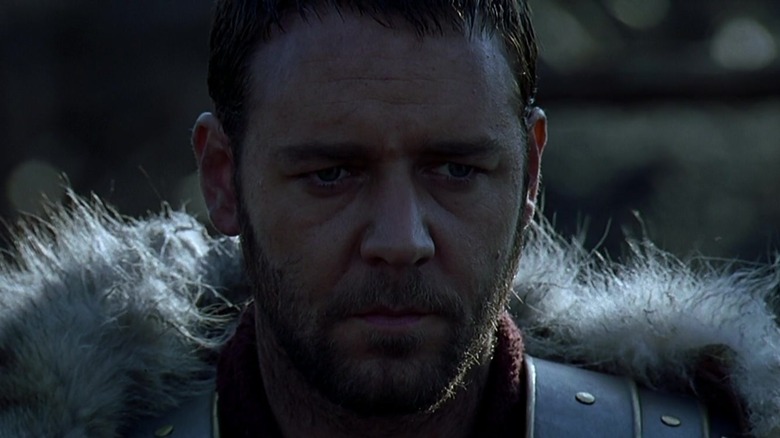
Ridley Scott's "Gladiator," released in 2000, remains one of the most epic historical dramas of the 21st century (via Esquire ). From its sweeping cinematography and soul-stirring musical score by Hans Zimmer to its deeply moving storyline and romance that endures beyond death, it represents a modern classic. Elaborate sets, sumptuous costumes, and flawless action scenes present the Roman Empire at its height, with clear shadows of the fall to come. What's more, the movie features incredible performances by Russell Crowe as Maximus Decimus Meridus and Joaquin Phoenix as the villainous Emperor Commodus.
According to IMDB , "Gladiator" cost roughly $103,000,000 to produce and grossed $34,819,017 in its opening weekend in the U.S. and Canada alone. And when all was said and done, the movie's worldwide gross came in at a whopping $465,380,802. But impressive statistics aside, there are many unanswered questions regarding the historical basis for "Gladiator."
For example, did a Roman General named Maximus ever exist? And did he end up in the gladiatorial ring due to a stroke of cruel fate? As for Commodus, was he really as bad as the film makes him out to be? Here's what you need to know about the true history that inspired "Gladiator."
The struggle was real in Germania
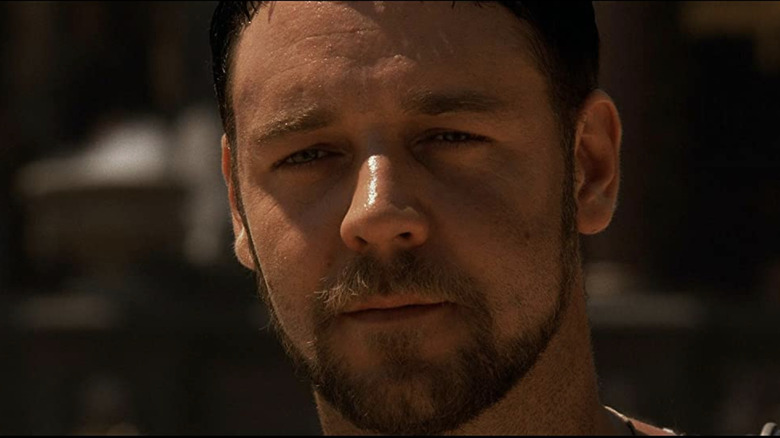
It's hard to beat the opening scenes of "Gladiator" (via Screen Rant ). A headless rider breeches the tension, sent into a Roman camp by opposing Germanic tribesmen. They punctuate the intimidating message by throwing the rider's head in next, complete with ancient Germanic insult-hurling. Of course, the ancient Romans, never ones to shrink from a fight, remain stalwart.
Without a second thought, Field General Maximus Decimus Meridus orders a hailstorm (or, rather, firestorm) of flaming arrows and other incendiaries. Then, he sends in his troops to crush the opposition, all while Emperor Marcus Aurelius watches breathlessly from a safe distance. Few scenes in cinematic history prove as bloodthirsty and fantastic. From Maximus' epic "what we do in life echoes in eternity" speech to the hardened Roman legion to the eerie forest setting. But did this battle actually take place? According to the Princeton Encyclopedia of Classical Sites , it sure did — at Vindobona, the modern-day site of Vienna.
The catapults launching flaming projectiles and the bolt throwers prove suspect, however. Sure, these weapons existed for stationary defense. But using them as siege weapons on a portion of the forested frontier? Not so much. But the battle did pit Roman soldiers against the indigenous people of Germania. And Ridley Scott got much more or less correct about the end of Emperor Marcus Aurelius' Twelve Year Campaign, which began in 167 or 168 A.D. (via Britannica ). The Battle of Vindobona marked the decisive win the Romans needed to clinch this conflict.
The (not-real) historically accurate hero
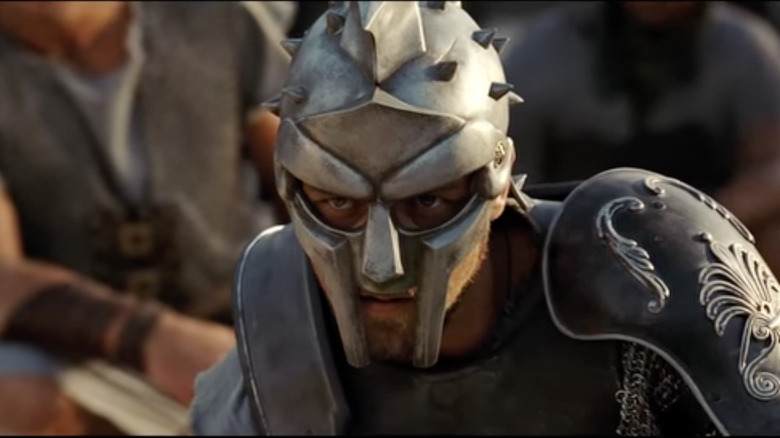
Maximus Decimus Meridius was a fictional vessel thought up by Hollywood mavens to effectively tell the story they envisioned. Nevertheless, his character is firmly grounded in actual history, from his bearing and demeanor to his dreams of becoming a farmer once his military service ends.
According to ThoughtCo. , the model of a Roman man dates back to Lucius Quinctius Cincinnatus. He lived in the 5th century B.C., and was a celebrated statesman, military man, and ... you guessed it ... farmer. Of these three titles, farmer best suited him. Kind of like Maximus, from the opening scene of the movie to the last. That said, Cincinnatus sacrificed all when the Roman Republic needed his help (despite the fact a lengthy absence on his part meant the ruin of his farm and food insecurity of his family).
Fortunately, he didn't meet the same nasty fate as Maximus. Instead, Cincinnatus became a prominent character in Roman literature as a "model of Roman virtue." Besides the example that Cincinnatus set, he also displayed two Roman virtues in spades: fides and pietas. According to The Great Courses Daily , fides translates as "faithfulness." But it refers to something much broader, "sticking to a task and seeing it through to the bitter end." As for pietas? In a word, it means "piety." Again, there's a deeper implied meaning, "doing the right thing." These two traits define Maximus' character throughout "Gladiator."
Infighting between the Praetorian Guard and the Legion
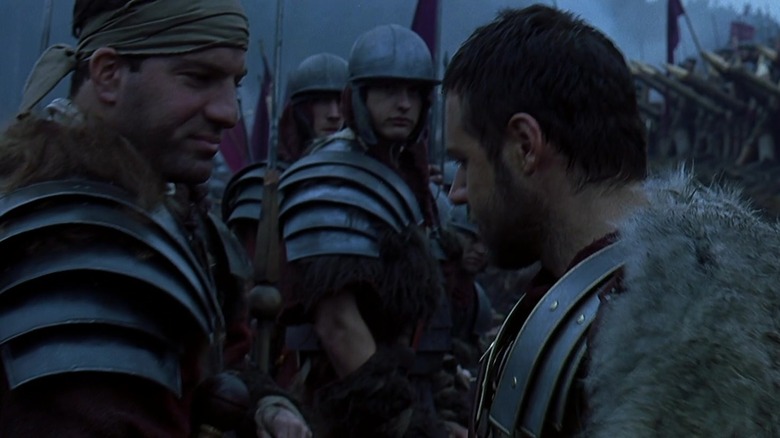
Remember when Maximus Decimus Meridius kills his would-be executioners, referring to one derisively as "Praetorian"? There's legit historical context for this event. Serious tension existed between the Praetorian Guard and the Legion.
The Praetorian Guard had a less-than-stellar reputation as the personal guard of the Roman Emperor (per World History ). According to the History of Yesterday, they assassinated 13 of the emperors in their care and "even auctioned the throne to the highest bidder." The infamy associated with the terror, treachery, and greed they caused soon preceded them. Surprisingly, things started out okay. Caesar Augustus assembled the unit as his personal bodyguard in 27 B.C., and he enjoyed a long life. Three centuries later, however, deep-seated corruption shrouded the military unit. Not only did they murder the men entrusted to their care (isn't there a circle of hell for this?), but they held some emperors hostage, wielding political power through the sword.
The Guard ballooned from 4,500 soldiers to 15,000 by late imperial times, and they received triple the pay of legionaries like Maximus and his men. Instead of serving 20 years, the Praetorians got off at just 16. And as you can imagine, each new emperor had to pay the Guard steep bribes to stay alive. Things finally came to a head under the reign of Emperor Constantine I, who managed to disband the unit without getting skewered in the process.
Legions and their generals proved thick as thieves
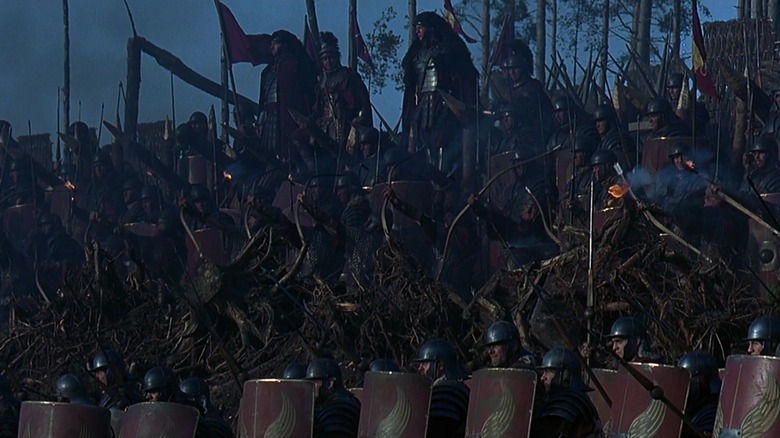
There's nothing like suffering through battles, blood loss, and uncomfortable deployment living conditions together. These realities of life on the warpath cemented a deep and abiding sense of loyalty for the soldiers of Roman legions and their generals, per PBS . "While soldiers were loyal to their emperor, this loyalty was nothing compared to the loyalty felt by many legions to their commanders." So, the blind faith that Maximus Decimus Meridus' men have in him proves spot-on.
Not only did hardship bind these troops and their leaders together, but they had an unprecedented focus on discipline. No army on the planet compared with the training of Rome's legionaries. Nonetheless, danger still abounded when invading enemy territory.
Rome's frontiers proved especially challenging for the soldiers posted there. Why? Because they never had sufficient supplies, got no breaks from the rigamarole of being a soldier, and faced constant hostility from native peoples. There weren't any local bars to unwind in after hours, and getting lost on a bathroom break in the forest could mean a violent death. Despite all the aforementioned discipline and training, death constantly loomed. Nothing better illustrates this than the unexplained disappearance of 5,000 soldiers of the Ninth Legion along the English-Scottish border during the Emperor Hadrian's reign. Their final fate remains a mystery to this day, according to the BBC .
Marcus Aurelius really was a cool old dude
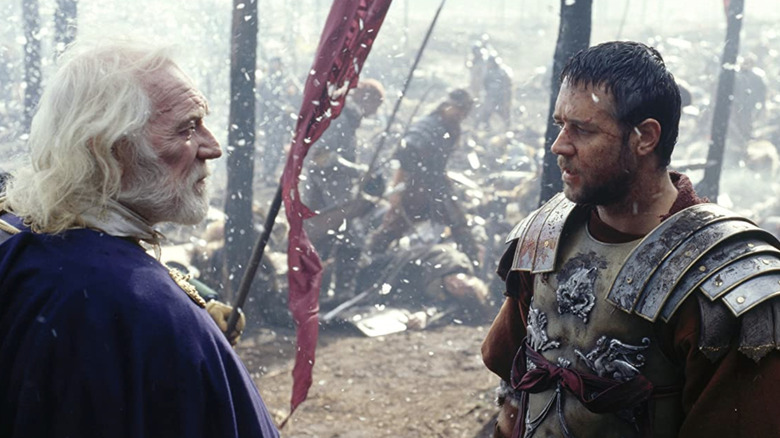
Marcus Aurelius was far from your average bloodthirsty, power-hungry, and ruthless emperor (via Britannica ). He insisted his adoptive brother Lucius Verus co-rule with him, an unprecedented move in Roman history. Verus had a meager fanbase and represented a "sitting duck" easily scratched out by a man less-reputable than Marcus Aurelius.
But Aurelius' adoptive father, Emperor Antoninus Pius, had requested the unique arrangement. Aurelius proved a man of his word. In an age when people often had little choice over their career paths, Aurelius proved no different. He longed to be a bookworm and philosopher rather than a great military leader and statesman. Towards the end of his life, he wrote in a journal since published as "Meditations." The work attempts to reconcile his life and daily activities with his stoic philosophy and desire to study, per History .
The movie "Gladiator" depicts Marcus Aurelius as a logical, justice-minded, and competent individual who spent a lot of time thinking. In this sense, it does a decent job of describing his actual character and interests. What's more, many scholars believe Aurelius died on the frontier at Vindobona as the movie depicts. However, overwork and stress got him in the end rather than Commodus' murderous grip. That said, you can't blame Ridley Scott for wanting to spice things up a bit. After all, watching a workaholic's dying breaths would have done little to demonstrate Commodus' irrevocably flawed character.
Commodus was a truly nasty guy
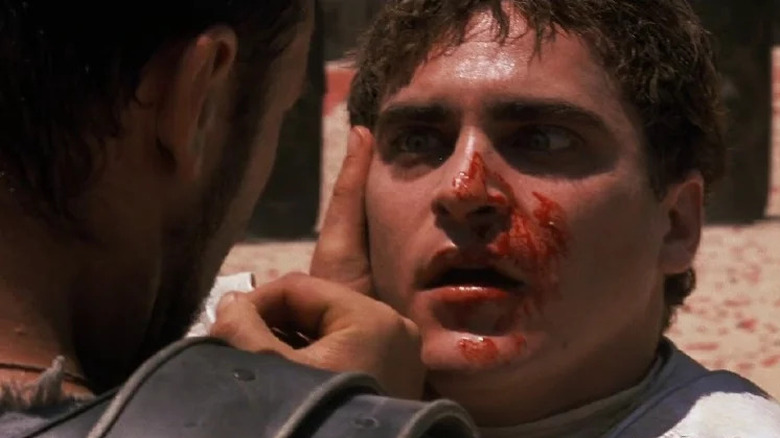
The movie "Gladiator" depicts Commodus as a true uber-villain, and this is no exaggeration. If anything, Hollywood handled him with kid gloves. The real-life ruler gave Caligula and Nero runs for their money. No wonder he enjoyed a short career as Roman emperor, murdered by a wrestler while taking a bath at the ripe old age of 31 Britannica explains that "His brutal misrule precipitated civil strife that ended 84 years of stability and prosperity within the empire." That's quite a legacy.
All That's Interesting sums Commodus up as "a paranoid megalomaniac who played gladiator and thought he was a god." Declaring himself the Greek god Herakles incarnate, Commodus commissioned a marble bust in the accouterments of the Hellenic hero, including Hesperides' golden apples, a club, and a lion skin headdress. A standard-bearer for Roman portraiture by today's standards (per Musei Capitolini ), at least Commodus knew how to choose a sculptor!
As a tween, he had a servant thrown to his death in a furnace for providing lukewarm bathwater (via the Los Angeles Times ). As an emperor, he kept a harem of more than 600 boys and women. He shirked his leadership duties, leaving them to Marcia, his mistress, and a handful of other self-serving favorites. And he focused on his gladiatorial career, charging the empire the ridiculous sum of 25,000 silver pieces each time he fought. History tells us he made 735 appearances. Do the math on that!
Rome did have a Senate
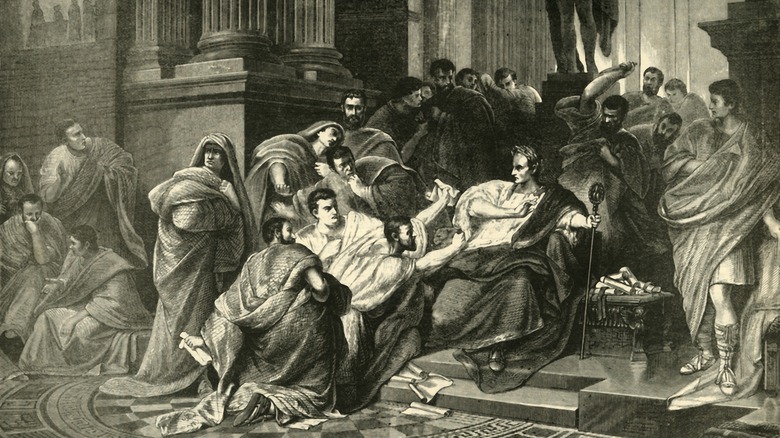
The movie "Gladiator" depicts Roman senators opposing Commodus. This longstanding institution endured both the Republic and the Empire. But the film also couches them in an anachronistic democratic context that didn't exist. Although the Roman Republic boasted a democratic constitution, "in practice [it was] a fundamentally undemocratic society, dominated by a select caste of wealthy aristocrats" (via Inquiries Journal ). What's more, by the time of Commodus, centuries cemented the transition to an empire.
The Republic came crashing down with Julius Caesar's power grab in 60 B.C. Sure, this resulted in his stabbing death on the floor of the Roman Senate by a group of senators. (Talk about cutthroat politics!) But even assassination couldn't take the nation off its trajectory into imperial despotism. According to The Collector , "the Roman Senate saw dramatic changes to its composition, influence, and powers" over the many centuries of the civilization's existence.
Surprisingly, the senators would outlive almost every other institution of Rome, including the vaunted emperors. Perhaps this makes their name even more fitting. You see, the word senator comes from the Latin term senex, which translates simply as "old man." So, what did "Gladiator" get right about the senators? For starters, they're accurately dressed and have the distinguished bearing, white hair, and beards you'd expect from these iconic "old men." And a conspiracy to remove Commodus from power existed, according to the Los Angeles Times .
The complicated relationship between Commodus and Lucilla
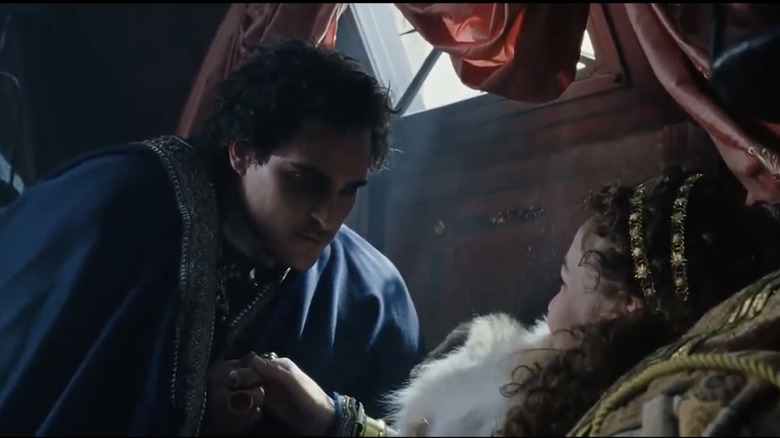
To say the relationship between Commodus and his sister Lucilla was complicated is an understatement. But no historical evidence points to physical attraction between Commodus and his sister. After all, he had 600 sex slaves, a mistress, and a wife to keep him busy. But Lucilla did operate as one of the most influential and politically powerful women in the Empire, per Bust . And she did engineer a failed assassination attempt on her brother, which later resulted in Commodus having her killed. See what we mean by complicated?
According to the Los Angeles Times , she turned to the Roman Senate for support in killing her brother. Why had senators turned against Commodus? Certainly not based on ideological principles or an attempt to restore the empire to its former republican glory. Nope, Commodus raised their ire by increasing their taxes, becoming the "betrayer of his own senatorial class."
The senators engineered their leader's death by sending a dagger-wielding assassin after him as he walked through a dark passageway. As the assailant came in for the kill, he screamed, "This is what the Senate sends thee!" But his breath proved not only wasted but highly incriminating. Quickly disarmed and killed, the would-be murderer's premature words contributed to the execution of many Roman senators, something you sure don't see in "Gladiator."
Gladiatorial competitions were wildly popular
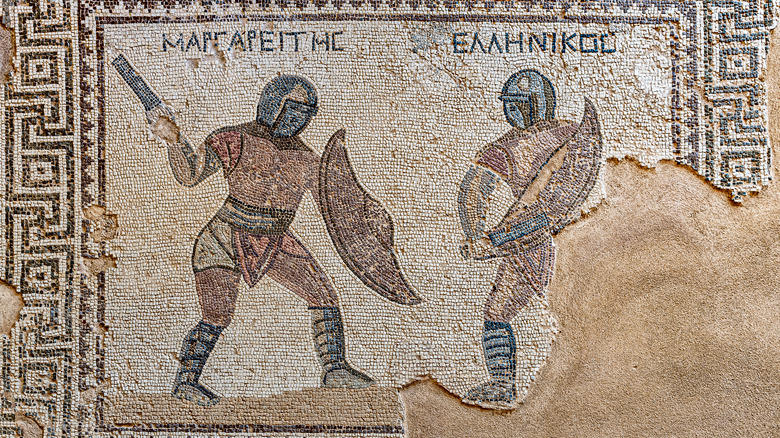
Rome's famed gladiatorial games proved just as savage and popular as the movie portrays them. They included men chained together and fighting in pairs, the introduction of starved and ferocious wild animals, trap doors, and much more (via the Los Angeles Times ). And Ridley Scott had a field day including some of these elements in his film.
What's more, the movie gets right just how popular certain gladiators could become. Perhaps this is best illustrated by the story of Flamma, a Syrian soldier-turned-gladiator (per Mental Floss ). He proved so skilled and entertaining in the ring that Roman politicians offered him four chances at freedom. But addicted to the blood, adrenaline, and fame of the Coliseum, he refused. After all, History tells us that gladiators could quickly rise to the ranks as veritable sex symbols. (Gladiator sweat even got marketed as an aphrodisiac.) Unfortunately, Flamma's love affair with the fame that came with the blade caused his premature undoing. By 30, he lay dead in the ring. Yet, the Romans so adored him that his face got minted on coins!
And if you think Scott's grandiose vision of gladiatorial competitions proves a little over the top, think again. The Romans spared no expense when it came to entertaining the masses. Emperor Titus had the Coliseum filled with water in 80 A.D. to host a re-enactment of a naval battle involving 3,000 men.
The social status of gladiators
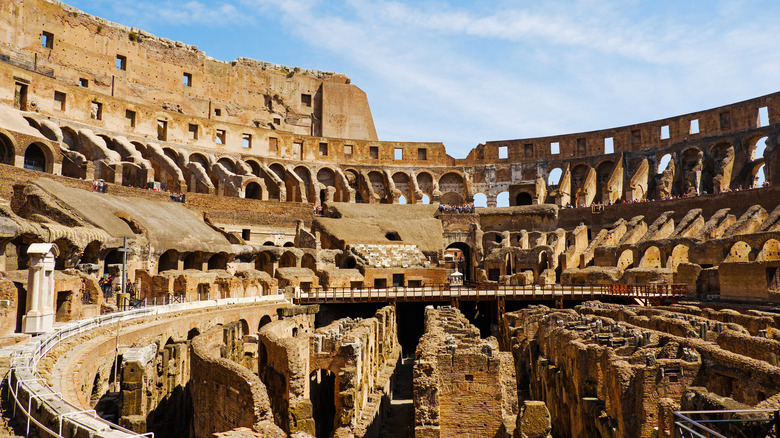
"Gladiator" focuses primarily on Maximus Decimus Meridus' time as a slave compelled to compete in gladiatorial competitions. And this proved a historical reality for many who fought in the ring. According to History , Rome fueled its bloodlust, especially early on, by forcing conquered and imprisoned people into gladiatorial combat. Criminals who committed particularly nasty offences could also find themselves fighting for their lives before the masses. But a study of grave inscriptions from the 1st century A.D. points to an evolution of combatants.
Over time, free men started signing contracts to become gladiators. And could you blame them? I mean, Commodus himself couldn't overcome the lure of adoring fans. These men came from various social classes stretching from impoverished individuals in pursuit of a lucky strike to ex-soldiers and even upper-class individuals and senators ready to show off their fighting prowess.
According to the BBC , "To the Romans themselves, the institution of the arena was one of the defining features of their civilisation." When viewed within this context, it's a little easier to see why men who never needed to be in harm's way would give it all up for a chance to kill each other to satiate roaring mobs. (And the down payment they received upon signing their contract wasn't a meager incentive either.) But a downside did exist. Gladiators who received money faced lifelong infamy as members of Rome's disreputable professions, along with sex workers and actors.
Gladiators could and did win their freedom
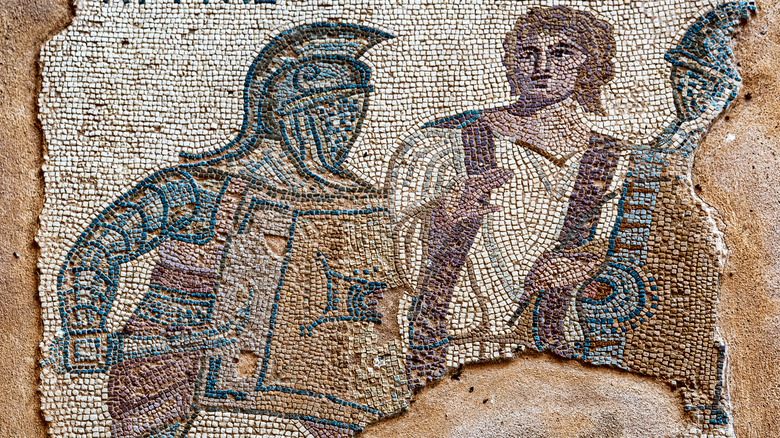
One of "Gladiator's" most beloved characters is Proximo, a former gladiator-turned-owner of fellow gladiators. He tells Maximus about receiving his freedom from Emperor Marcus Aurelius via the gift of a wooden sword. Known as a rudis or rudes, gladiators trained and sparred with them (via ThoughtCo. ). When an individual decisively won a competition, securing his or her freedom, they received a rudis and a palm branch, symbols of newly won liberty.
One of the most interesting gladiator-related historical accounts comes from the poet Martial, who recounted two gladiators fighting for hours. Their well-matched bravery and skill won the hearts of the crowds and resulted in a stalemate. Then, the unthinkable occurred. Both warriors received a rudis and palm branch from the emperor.
What happened to retired gladiators? They forged a new profession. Some became farmers. Others went on to train future gladiators at a local school. The most fortunate warriors rose to the ranks of summa rudis, an elite group that wore white tunics trimmed with purple, denoting their standing. They carried whips or batons, using them to point out illegal maneuvers, and they ensured that "the gladiators fought bravely, skillfully, and according to the rules." After all, strict rules of conduct existed despite Ridley Scott's depictions of seemingly no-holds-barred events.
Recommended

IMAGES
VIDEO
COMMENTS
Gladiator, the Oscar-winning 2000 movie from Ridley Scott, takes creative license with the factual events of Ancient Rome, but some aspects reflect real historical truths such as the process of granting freedom to gladiators.
The historians who were hired to advise the movie quit or refused to be given credits because of the many historical inaccuracies the final version had. Nevertheless, as with most historical dramas, this movie was more about entertainment than historical narrative.
Especially for a movie focusing on Roman politics and the lives of emperors and slaves, a question naturally arises: just how historically accurate is it?
Gladiator doesn't rise to Braveheart-levels of outright disregard towards history, but the movie also isn't something one should use in lieu of actual history books when studying Roman history. Here's how accurate Gladiator is to the history of Rome and how close it is to the Gladiator true story.
Gladiator's opening scene depicts the chaos and grandeur of war, while also aiming for historical accuracy in its portrayal of the Roman military. The Roman army's armor and weapons in the movie are mostly historically accurate, including the use of lorica segmentata armor and the spatha sword.
But impressive statistics aside, there are many unanswered questions regarding the historical basis for "Gladiator." For example, did a Roman General named Maximus ever exist? And did he end up in the gladiatorial ring due to a stroke of cruel fate?
How historically accurate is GLADIATOR? While the movie is not based on any specific reported or historical incident, the movie is steeped in history. Several of my friends' reaction to...
Historian and host of 'The Ancients' podcast, Tristan Hughes, dives deep into the historical accuracy of Ridley Scott's 'Gladiator'. The battle over the film...
Gladiator is a 2000 historical epic film directed by Ridley Scott and written by David Franzoni, John Logan, and William Nicholson. It stars Russell Crowe, Joaquin Phoenix, Connie Nielsen, Oliver Reed, Derek Jacobi, Djimon Hounsou and Richard Harris.
The Gladiator, directed by Ridley Scott and staring Russell Crowe, provides us with better looking, more realistic sets than its chariot predecessors, including the interior of the Emperor's palace and the Colosseum in Rome. The sets are the real star of this film.